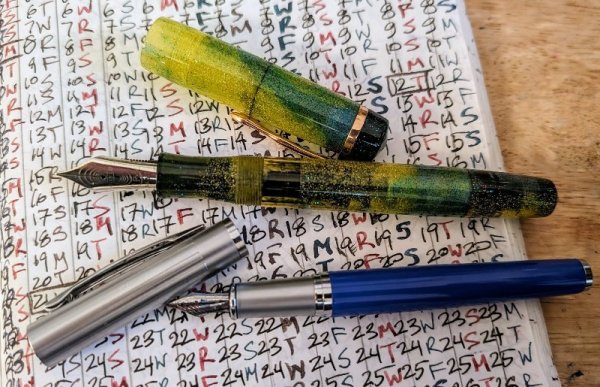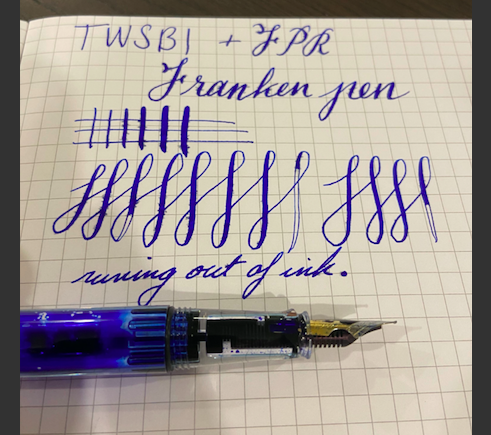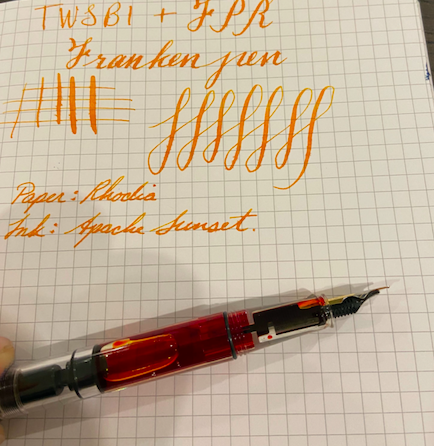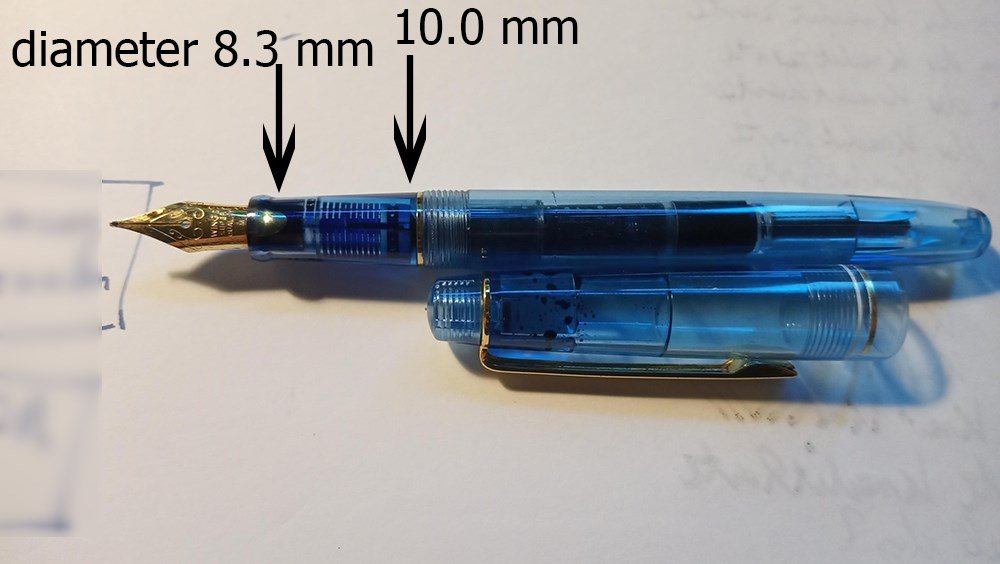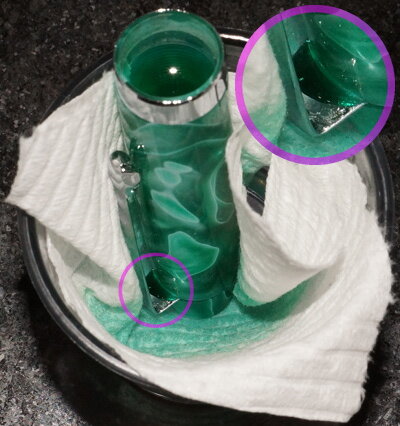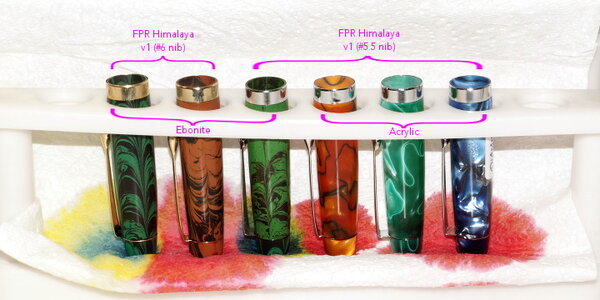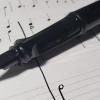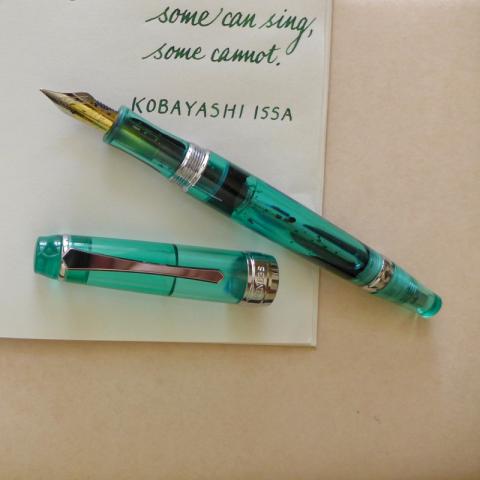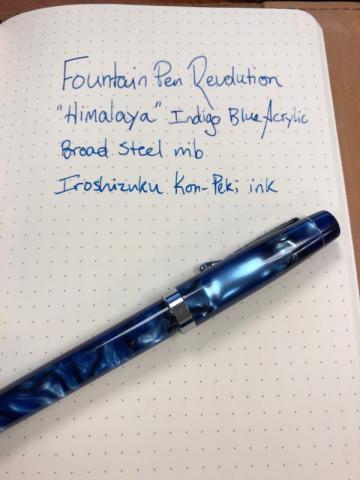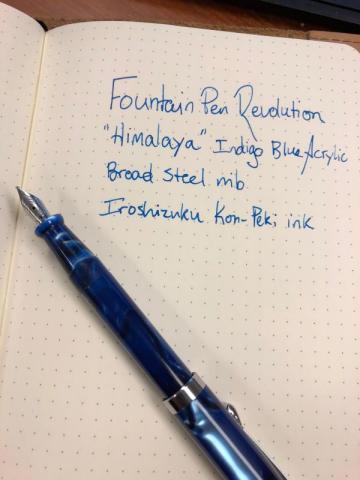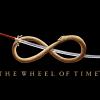Search the Community
Showing results for tags 'fpr'.
-
Here's a brief comparison of 3 modern flex nibs: Conklin Omniflex, Noodler's Ahab, Fountain Pen Revolution Flex. Ease of flex Conklin Omniflex FPR flex Noodler's Line variation FPR flex - the nib writes finer "naturally" Noodler's Conklin Omniflex Railroading They all railroad at some point but it depends so much on how quick, how often and how hard you flex that this is really where I need to call in the YMMV. That being said, my Ahab is the most reliable and sturdy. Nib "feel" Conklin Omniflex feels the most fragile: the metal seems the thinnest, and I don't dare pushing it too much, Noodler's Ahab feels the sturdiest of the three, smooth even flexed to its maximum. Normal writing FPR has the finest line and feels almost italicized, a bit dry and doesn't keep up well with my rather fast writing. That might be something I can fix with brass sheets etc but I don't want to alter the line variation so I'll wait! Noodler's pleases me the most: smooth, a fine medium, still wet, always keeps up. Conklin: meh, nothing to say. Conclusion As much as it kills me to say it, the FPR flex nib is the best in terms of flex, you can get very "calligraphic" with it. The Conklin Omniflex just feels too fragile to me - I must be able to feel comfortable otherwise I might as well go back to dip pen nibs. The Ahab is just the most versatile of all: I love it as an everyday writer, I still love flexing it even after the beautiful discovery of FPR nib. I'll try to swap the FPR nib onto the Ahab and see how I like it (as I don't like the Himalaya V2 pen that much) but I'm pretty sure I want to keep the Ahab as is.
-
Modern inexpensive flex nibs: Bluedew Flex vs FPR Ultra Flex
ParkerBeta posted a topic in Fountain Pen Reviews
We often hear that there is no modern equivalent to the vintage "wet noodle" flex nibs of 80-90 years ago. In recent years, some pen makers are making a concerted effort to create flex nibs that do achieve the line width variation, snapback, and lack-of-railroading of those fabled vintage flex nibs. Some are expensive gold nibs mounted on expensive bodies (Aurora, Montblanc 149 Calligraphy, Scribo Feel), with the pen and nib together costing between $500 and $1000. I approached the "modern flex" question out of curiosity, and my curiosity does not extend to spending several hundreds of dollars to investigate the question. Instead, let us take a look at two reasonably priced (even if not quite "inexpensive", notwithstanding the title of this post) flex-nibbed pens, starting with the Bluedew. This is a pen created by a Singaporean inventor named Jeffrey, and it is all about the flex nib. Indeed, he founded the company to sell the nib, with a pen around it. The pen sells for USD88, ships worldwide for an additional USD12, and as you can imagine for that price you get a stainless steel nib and not a gold one, although you do get a very nice faux-leather single-pen case that can hold a good-sized pen (and is in fact the only packaging for the Bluedew pen itself during transit). Kudos for no-waste packaging! Now, about the nib itself, it has long narrow tines and a very interesting pattern in place of a simple breather hole. If you read the FAQ on bluedewpens.com you will see that everything about the nib was designed in order to extract maximum flex from it, even the embossed "B" on the nib (which is supposed to trap a small amount of excess ink under the raised "B"). The Bluedew flex-nib pen. Multiple body colors are available, including (obviously) a blue colorway, but at the time I went to the website this translucent finish was the best-looking option they had in stock. It has faint pink swirls in the resin, and there is a "BLUEDEW" engraved on the barrel. The cap is unmarked. The pen is 140mm capped, 125mm uncapped, and the grip section is between 10mm and 11mm in diameter. The fit and finish of the pen are definitely in the uppermost range of what is available at this price point. The barrel threads are precise and the pen can be easily eyedroppered (maybe with a little silicone grease applied to the threads for peace of mind), although I have only used the pen with the converter and a cartridge. Ink flow does seem to be wetter with the converter, by the way. Unfortunately, the converter looks like a proprietary design even though the cartridges it takes are the standard international size. Here you get a closer look at the details of the nib. Unlike several other flex nibs that are created from stock steel nibs by cutting out scoops from the sides, this nib was designed from scratch, according to the Bluedew inventor Jeffrey, and the interesting breather hole pattern, the two cuts (parallel to the slit) on the two sides of the slit, and the horizontal ribbing above the breather hole all testify to a novel design. Remarkably, the feed is plastic and not ebonite, and there is an explanation for this choice in the FAQ on the site. Next, let's take a look at the other modern flex-nib contender, the FPR "Ultra Flex" nib from Fountain Pen Revolution (FPR), a company headquartered in Texas that made its reputation by commissioning inexpensive but reliable fountain pens from manufacturers in India and offering sales and warranty support right here in the USA, together with excellent and responsive customer service. (Like Bluedew, FPR is also essentially a one-person company. It is inspiring that small companies founded by individual enthusiasts are bringing the innovation to this century-old space that the big pen-manufacturing corporations have chosen not to address.) Now, this FPR Ultra Flex nib is available mounted on a variety of pens sold by FPR, but I opted for the somewhat expensive (relative to the rest of the FPR lineup) model called the "Tanoshii." This is also a departure for FPR in that this pen is made in collaboration not with an Indian manufacturer but a Japanese manufacturer. There is a thread elsewhere on FPN speculating as to whether the pen is actually made in Japan or made in Taiwan by a Taiwanese subcontractor to said Japanese manufacturer, but wherever it is made, it is made very well. This body costs around $70 and the Ultra Flex nib is an additional $14, bringing the total almost to the same amount as the Bluedew. As you can see, the pen is strongly influenced by the Delta Dolce Vita down to the black cap with orange body and gold plated trim. The thick cap band (obscured in this picture, but visible in the close-up photograph of the nib below) is also decorated with a motif just like the no-longer-made Dolce Vita by the now-defunct Delta. The clip seems to have a little roller but the roller appears to be fixed and does not actually roll. In contrast to the Bluedew pen, the Tanoshii design is a flat-top and slightly shorter (135mm capped) but the section is slightly girthier (10.5mm). Again, fit and finish are in the 90th percentile for a pen in this price range (although unlike in the Bluedew, the barrel threads do not screw into the section with such tight tolerance that I would be entirely comfortable with eyedroppering it), and the orange resin looks lovely. You can also get it in black, or with a light blue barrel, or with a red barrel and a white cap (the only option without a black cap). It is also a C/C filler that accepts standard international sized cartridges, but the included converter is not as "premium" feeling as the one on the Bluedew. Here you can see the cap band design and more importantly, a close-up of the nib. This nib, also made of stainless steel, is of a more conventional design for a modern flex nib, being cut by hand (by Kevin, the founder/owner of FPR) from a stock steel nib. Note the very deep slit and the two cut-out scoops on the two sides. If purchased on its own, this nib can be acquired paired with an ebonite feed, but when acquired as an upgrade option with the Tanoshii, the Ultra Flex nib comes with a plastic feed. Kevin says it keeps up with flow requirements pretty well and the writing sample below will confirm that. Now, on to the writing test(s). I have previously written a couple of converter-fulls with both of these pens, but for the tests today I took the lazy route and used a "mystery" cartridge (that I think is Monteverde Purple Reign) on a Doane Paper Utility Notebook with the Boxcar ruling. This paper offers a great textured surface suitable for all nibs, but it is absorbent and has severe bleed through with most inks. Clearly, the FPR nib is much, much wetter than the Bluedew nib. On the other hand, the Bluedew nib, maybe because it is drier, actually shows the line-width variation one expects, although it railroads before hitting the 1.5mm BB limit as claimed by its manufacturer (I did get close to that limit using the converter, though, but I don't have evidence of that today). The FPR nib actually dumps so much ink on the page that it caused severe feathering (clearly visible above in the figure-eights) and bleed through (not shown), while also obscuring the full range of line-width variation possible with this nib. My experience with both cartridge and converter is that the FPR Ultra Flex nib does not actually get down to EF thinness while the Bluedew can. On the other hand, the FPR nib gets to BB thickness easier than the Bluedew nib does. As for the pressure required to get flex, this is where I think we are finally approaching parity with the vintage flex nibs, and this is great news. Both nibs flex under little to light pressure, though I would say that the Bluedew nib flexes even easier than the FPR -- to be expected, I suppose, from a nib that was designed as a flex nib from scratch. I must say that I have not tried the expensive gold flex nibs on Aurora, Scribo, or the Montblanc 149 Calligraphy pen, but I have tried (once, briefly) the 14kt "quill" nib on a Pineider, and from my recollection, both of these steel nibs (Bluedew and FPR) flex more easily and with lighter pressure than that (significantly more expensive) Pineider nib. This is genuinely impressive and cause for celebration. In short, you won't go wrong with either one if you want to explore a modern-day flex nib without breaking the bank. The FPR Ultra Flex requires a bit more pressure to begin flexing than the Bluedew, so if you want to only occasionally flex in your normal, everyday writing, the FPR nib may be a better option. On the other hand, the Bluedew nib exists for one, and only one purpose, so you had better be prepared to flex with every letter you write with it. The good news is that it will do so pretty much on its own if you just write with normal pressure as you would with a non-flex nib. -
-
- newtonpens
- fprevolution
-
(and 3 more)
Tagged with:
-
I ordered four Gurus when they were 40% off for Black Friday, & several inks. Got them today, gave them a quick wash, and inked them up. Each pen has some slight imperfections & scratches, but for under $5 I'm not terribly fussed. I haven't noticed any odor from the vegetal resin; given how often reviews mention it I was surprised. I was also surprised to find I like the extra fine nib more than the medium, exactly the opposite of what I expected. I'm sure I'll like the pens & the inks more when I try them on FP friendly paper. I hoped this notebook was, but nope. So far, I'm wondering why I bought these when my Pilot Varsity seems just as good, though more difficult to reink. Anyway, here's a sample of four pens & four inks, on an old unbranded notebook. Pics of the pens later! Perhaps when I swap in the architect nib I also ordered.
- 4 replies
-
- new pen day
- new ink day
-
(and 2 more)
Tagged with:
-
TWSBI FRANKENPEN Flex Hi all I've been in search of a twsbi with a flex nib and with some work I was able to tinker with a TWSBI Eco and an FPR Ultraflex to create a flexy TWSBI Eco and I wanted to share what I did and how it turned out. I have heard of Fountain pen revolution and recently I have had the pleasure of purchasing a few of their pens. Great pens and seamless experience. One of the pens that I purchased from FPR was the Indus pen. Comparing the feeds of the TWSBI Eco and the Indus, the feeds looked to be the same size. 1. The first thing I tried was straight swapping the nib/feed from the Indus pen into the TWSBI Eco. This wasn't successful because the feed while of a similar size was not exactly the same and didn't seat well into the Eco. 2. My next attempt was to take the feed from the Eco and put the FPR nib on it. At first glance there was a gap between the nib and the feed. When searching through fpn history I found that there were two possible solutions. Either to bend the nib to meet the feed or to somehow bend the feed to meet the nib. The recommendation was to whenever possible bend the feed. Bending the nib may result in tines too close together. 3. The solution is not recommended and not for the faint of heart but did work YMMV. Its common knowledge that you can heat set an ebonite feed, however the TWSBI feed is plastic. Per suggestions I boiled a cup of water and held part of the feed under water for 10 seconds. Then I slowly and little by little pressed the feed against a solid counter to force the feed to bend upwards (repeat as necessary, better safe than sorry). 4. At this point I put the FPR Nib + TWSBI feed and section together and ended up with a pen that wrote. Another problem arose while I fiddled with the nib. It was super loose ( no effort to remove the nib ). Back to FPN I went for suggestions. I found a few solutions, either to use shellac to create a wedging effect or to bend the nib at the base (furthest part of the nib away from the writing tip) by flattening it a bit. Also risky and not recommended for the faint of heart. Little by little I got the feed nib and section to play well together. I've attached some shots of the writing (first image I was running low on ink which caused the railroading)
-
Beginner flex nibs and FPR Ultra flex combinations?
IanP2303 posted a topic in Fountain & Dip Pens - First Stop
Hello, I am looking to buy a flex pen for beginners, I have already read some of the threads here regarding beginner flex pens, but I am not sure whether some new, quality and affordable flex pens are released recently. Therefore, I started this topic and I hope that you blokes can help me with it. I also heard that Fountain Pen Revolution has a great Ultra Flex nib, are there any pens that are suitable for this nib, as I would love to try it out. Thanks, Ian -
Is anyone here familiar with FPR's nib-marking conventions? I bought a couple of FPR's Majestic pens, one Clear with 1.0mm Stub & the other in Red with Med Nib. Both are pictured here together (pls see), and as easily discerned, the Stub is plainly marked as such, but the other (red pen) only shows what appears to be a tiny 'square', slightly offset left-of-center at base of the stamped 'nib' marking. Nowhere can I find anything resembling an 'M' for Medium. (2nd photo shows a little better view) Notably perhaps, there's also a distinct difference in the brand-markings on each. Both, btw, came in on the same order, not like weeks or months apart. Can someone who knows please describe what's going on here? I know NOW because it just came in & is fresh on my mind. But how do I know what it is when I pick it up again 6 months from now?. TIA!, _/_/
-
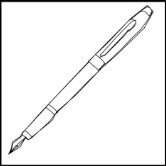
Could I put a FPR 14k or Edison 18k nib in a Conklin Duragraph?
collectorofmanythings posted a topic in Of Nibs & Tines
Hello! I love the look of many Conklin pens, especially the Duragraph, and the steel JoWo nibs are just fine, but I would love to put a gold nib in it. I saw that both Edison and FPR make gold nibs (I especially like FPR because it is $20 cheaper) in the #6 size and was wondering if anyone thinks this is a good idea or if anyone has ever tried it. Thank you for your help! W. H. Major- 5 replies
-
- conklin
- modern pen
-
(and 3 more)
Tagged with:
-

Could I put a 18k Edison nib or 14k FPR nib in a Conklin Duragraph? Is there any other gold nib I could get that would fit it for cheaper?
collectorofmanythings posted a topic in Of Nibs & Tines
Hello! I love the look of many Conklin pens, especially the Duragraph, and the steel JoWo nibs are just fine, but I would love to put a gold nib in it. I saw that both Edison and FPR make gold nibs (I especially like FPR because it is $20 cheaper) in the #6 size and was wondering if anyone thinks this is a good idea or if anyone has ever tried it. Thank you for your help! W. H. Major I posted this in the wrong section before. Oops! Reposting to the right place, which I think is this one. -
I was wondering if anyone knew if their #6 nib units (integrated fee) fit any other pens? Was thinking their ultraflex nib might be nice in other pens.
- 6 replies
-
- fountain pen revolution
- fpr
-
(and 2 more)
Tagged with:
-
What fountain pens can take FPR (fprevolutionusa) #5.5 Flex or Ultra Flex Nibs?
Orange22 posted a topic in Fountain & Dip Pens - First Stop
Hi. I hope someone can help me with this because till now I was unable to find a solution on google or even youtube. During the last year I bought about 10 different china pens. But he only one I feel comfortable writing with is the one on the photo. I think it’s a Pilot 78G copy and it fits perfect to my hand and the nib is also a bit flexible. So what I need is a plastic/resin pen that can fit a #5.5 Flex or Ultra Flex FPR nib AND has a thin section. Similar to the one on the photo. I contacted FPR already and the recommended me to go with a “Indus” but to me the section of that pen looks too wide. Thank you!! -
desaturated.thumb.gif.5cb70ef1e977aa313d11eea3616aba7d.gif)
My FPR Himalaya v1 in Emerald Green acrylic has a leaky cap
A Smug Dill posted a gallery image in FPN Image Albums
From the album: Assorted pens
This was what was observed during cleaning one day, which then prompted me to test all of my FPR Himalaya pens for the same issue — and they proved to all be flawed in this way, so I guess it's not an accident or just one dud unit I happened to get.© A Smug Dill
- 0 B
- x
-
From the album: Assorted pens
I think this goes to show the FPR Himalaya pens are not designed or made to provide an airtight seal when capped.© A Smug Dill
- 0 B
- x
-
Hi I didn't know where to put this so please delete if this is the wrong place, but... I wanted to know how to pick the right feed for my pen when buying from Fountain Pen Revolution. Here's the link in case anyone wants to see: https://fprevolutionusa.com/collections/5-5-nibs My pen has a feed that is 39mm long but I'm not sure that's what they're measuring here. Any and all help appreciated!
- 3 replies
-
- feed
- fountain pen
-
(and 3 more)
Tagged with:
-
The no. 6 flex nib from Fountain Pen Revolution fits in a Penbbs 456, this one in the absinthe material. The ebonite feed was shaved slightly to fit the plastic section housing. I modified this nib with wing scallops along the lines of the flex nib experiments in the thread below. FPR now sells these ultra flex nibs with wing scallops included. The ink is Diamine umber, and the paper is from MUJI. https://www.fountainpennetwork.com/forum/topic/324910-experiments-with-flex/
-
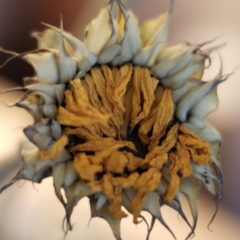
Honeymoon With The Fountain Pen Revolution (Fpr) Flagship: Jaipur V2 With Ultra Flex
peroride posted a topic in Fountain Pen Reviews
Family owned and operated, Fountain Pen Revolution has come out with their version 2 of the Jaipur fountain pen. Currently there are only 2 acrylics, a blue and an orange and 1 ebonite brown which is the subject of this first look reviewlet. What is it? A piston filler of Indian origin designed and branded by FPR along with a stable of other brands that they sell. The ebonite is smoother and finished better than the Himalaya v2. Himalaya looks and feels more matte whilst the Jaipur is slicker and sheenier. The length is a smidge longer and girthier than the Himalaya with a more cylindrical shape. I much prefer its profile over the himalaya v2 and that pen feels almost perfect. Comparison to an M600 would longer, less taper and slight less girth. Jaipur hits close to Lamy Safari dimensions. Left to right: Leonardo Momento Zero, Pelikan M600, FPR Jaipur v2 with Ultra Flex nib, Lamy Vista (clear Safari) and FPR Himalaya V2 The Jaiput v2 piston filler pen can be completely disassembled for maintenance which is a big plus. Additionally the ebonite feed and nib can be swapped for #6 plastic ones at the FPR shop. Takes about one and a half turns to uncap and Jaipur posts deep and secure. I totally love this. The pen is light at 19.5 grams on my coffee scale. How does it feel?Imagine a light Pelikan M800ish/Lamy Safari sized pen with a very slight tapered grip ending at a very clear and useful ink window. Add an ultra flex steel cut out shouldered nib tuned with an ebonite feed backed by unencumbered volume of piston full of ink. Finally, finally I have converted and firsthand witnessed the praise of pleasurable FPR affordable flex writing. I dare say it is up there with 4x more expensive 14K Gold Jowo flex. Unlike my first stutterings with Himalaya v2, Jaipur v2 wrote straight out of the box no problems. No flushing of feeds or heat settings or bum leaky convertors. I just rinsed the nib and .... WTH!! Let's backtrack... I received shipping at work and could not wait to get home to ink the baby up. Everything check out: no defects and superb build quality, piston worky if not a bit stiff. Knock on wood, I got one from the good batch?! then I came home all hot and bothered in the FP heat phase when to my surprise, I could not undo the blind cap. Blind cap? What's that you say? Well unlike a regular piston converter like Montblanc 146, Pelikan M series, Sailor Realo, etc etc FPR Jaipur v2 has a beautifully thin crafted end cap that the user screws to reveal the actual ribbed piston knob. Clockwise knobbing fills and counter will dispense. I could not get the dang thing off and then I heard a rattle sound and saw separation from the piston mechanism and barrel. We were not dealing with a captured converter here. So just before I'm ready to make love with my new pen, i dun brok it?!@ WTH!@#$ No amount of silicone gripper oven mitt strength twisting would undo the blind cap to access the knob for ink filling! I was really upset as I was not sure I was either tightening the blind cap or loosening it. It would not budge and so I had a pen that could not fill unless I syringed from the nib end which unscrews for nib swaps; basically Jaipur as a crappy eyedropper. Then I remembered FPR introductory video and rewatched for the direction of the twists during the Jaipur overview. https://youtu.be/rkX1p47KbM4 I ended up untwisting out the whole piston assembly then I was able to get better purchase on the blind cap and free it to expose the piston knob. But now I had a piston part to reattach. Luckily I was able to rescrew it back in and get the piston working again. I could filler up! Writing, writing and writingJaipur v2 chews ink up and I love it.Finally can go full plow and refill to use up ink stash. Akkerman Garuda Rood - wet juicy yumCrappy De Atramentis Bamboo Green ink sample - feather like crazy but still juicy though had a couple of skips and hard startsDiluted Organic Studio Nitro also sold at FPR - WOW BAM POW! that and Akkerman have been stellar. I dunno maybe it's the piston volume and not that skinny skank convertor of the Himalaya v2 but the Jaipur v2 feels like a homerun on the writing experience. Page after A5 page, I can just gush and pour without issue with the right ink. The only negatives were the super tightening of the blind cap which I did not truly did not over tightened which I "fixed" with silicone grease ?! to the inner threads AND hard to turn, stiff piston which I hope to fix with silicone grease to the ink chamber though I kinda don't want to mess up the honeymoon by unscrewing the nib and potentially ruins it!! In all, Jaipur v2 is a worthy flagship and I prefer it over my 2 Himalaya v2s: 1 good and the other meh . No heat setting, flushing, leaking, etc. I just fill and write now. As a true testament to this pen, I bought another one at the time of this reviewlet, this time in blue acrylic to see if it holds up to this faithful ebonite version. Hey, need more data points? Here's YouTuber Larry of Larry's Fountain Pens with a word: https://youtu.be/Rj2_eDTcSDU Peace out, write on! -
Looking For Most Recommended Modern Flex Pens
Vunter posted a topic in Fountain & Dip Pens - First Stop
I've been wanting to get into flex pens ever since I started using fountain pens a few years ago, but didn't want to get ahead of myself. So I started off with all the recommended beginner pens. I've been writing with all my pens for awhile and now I'm itching to get into flex but would like some recommendations. I've been watching a bunch of youtube videos and curious which flex pen most people here think has the best performance. I hear vintage flex is where its at, however I can't afford vintage flex so I have to stick to modern flex for now. Here are the modern flex pens I am aware of. Pilot FalconPilot Custom 912 - FA NibFPR Himalaya V2 Ultra FlexNoodlers Ahab, Boston, Creaper, Konrad, Neponset, tripleConklin OmniflexEdit - Desiderata PensLike I mentioned above I'm curious what the community thinks is the best performing modern flex pen and feel free to let me know of other ones that is worth looking into. I know mileage will vary. -
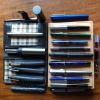
Fountain Pen Revolution "himalaya"--Hard To Beat At This Price
writerstephen posted a topic in Fountain Pen Reviews
A while back, I purchased a fountain pen called the Indus from Fountain Pen Revolution. With that pen, you get an integrated, piston-filler (capable of full disassembly) with a very smooth steel nib with ebonite feed. However, that pen had some quirks (like a wiggly clip, a weird smell, and a very skinny grip) that made it less than perfect, even at that price point. I still like and use my Indus, mainly because of its most excellent nib, but I don't love it as much as I could. For those who don't know, Fountain Pen Revolution (hereafter FPR) is a brand dedicated to low-cost fountain pens, all of which are manufactured in India. India produces some excellent pens--evidenced by the fact that some well-known brands (Stipula and Esterbrook come to mind) rebrand and price-up lesser-known Indian brands for the US fountain pen market. FPR is run by Kevin Theimann, a wonderfully friendly chap who is likely to send you a personal email thanking you for making an order. He's good people, and I'm hoping he succeeds with this business model. After getting my Indus, and perusing some other models on the FPR site, I was intrigued enough to try again. This time, I went for the "Himalaya" model: A thicker pen than the Indus, with a push-pull piston converter (think Noodler's Neponset), and the same #5.5 steel nib and a larger ebonite feed. I chose the Indigo Blue acrylic finish. When I opened the pen, all I could say was "Wow." The blue acrylic is simply stunning, with deep chatoyance and multiple swirls of color. I have two other pens with similar finish: a Levenger True Writer Classic and a Retro 1951 Tornado, and the Himalaya is more beautiful than either of those. The pen is of medium length and width, I’d say; almost the perfect size. I have large hands, and it fits me perfectly. I’d wager smaller hands would find it just as comfortable. The screw cap can be removed in one full rotation, and posts securely with an almost undetectable click. Posted, the pen measures just about 6 inches, which to my mind is just about the perfect length for writing. The grip section is nicely tapered with a flare at the nib end to keep your fingers from sliding off onto the nib. I’d almost wish the nib were larger, but the way this nib writes I can’t complain about that. The pen’s converter works perfectly. It screws into the section and there was already some silicone grease on the threads to ensure a good seal. I’ll make a note to replenish that from time to time. I inked it with Pilot Iroshizuku Kon-Peki to match the pen’s aesthetic, and did a quick writing test. Again, wow. This pen writes. On a scale of 1 to 10, with 10 meaning the nib slips across the paper as if it were made of ice, I give it a solid 8.5. My Waterman Expert 3 medium is a 9, and my TWSBI Diamond 580 broad is a 9.5. The Himalaya is a very smooth writer, and it’s already destined for my regular EDC rotation. I keep coming back to the price of this thing, but I can’t ignore it. I can’t think of another pen under $30 that looks and writes as well as this one. And don’t give me Lamy Safari and Pilot Metropolitan, those pens are good and all, but *yawn*. This is a beautiful pen with character, one that you won’t be afraid to take to the boardroom, and also one you won’t be too afraid of losing. If you haven’t yet checked out FPR, I recommend you do so today: the site is www.fountainpenrevolution.com.- 75 replies
-
Hey guys, I just thought I'd share this. Yesterday, I got a package from Fountain Pen Revolution, containing a FPR Guru with a flex nib and a spare #5.5 EF nib. The shape and curavture of the nib looked fairly close to the M200 EF nib, which I've always found way too broad. So I attempted to replace the Pelikan with the FPR nib and - voila! It works! FPR #5.5 nibs will fit on the Pelikan M200 nib unit! Of course. getting the nib out of its unit (and getting it back in) is a bit of a hassle, but it actually works. I haven't tried it with the flex nib yet, so I can't tell if the ink flow keeps up etc., but the normal steel nib works like a charm.
-

Fpr Roll-Up Pen Pouch (6 Pens)
namrehsnoom posted a topic in Paper & Pen Paraphernalia Reviews and Articles
FPR Leather Roll-Up Pen Pouch (6 pens) FPR - or Fountain Pen Revolution - is a family-owned business, founded in 2011 and situated in Texas USA. Their mission is to create high quality products at a very reasonable price. Besides fountain pens, they also offer some really nice pen pouches to carry them in. In this review I take a closer look at FPR's 6-pen roll-up pen pouch. The one I have is about 5 years old, and an older version of this product. They released an updated version of this pouch in 2019, with much better looks & aesthetics. The concept remains the same, and works perfectly as a daily carry for your inked-up pens. The pouch is made from flexible, but still strong leather, that you will enjoy for many years. My pouch is about 5 years old, and still good as new. Stitching is of high quality, without any visible damage due to time & use. In rolled-up state, the pouch is quite small: at 17x8 cm and about 4 cm thick, it doesn’t take up a lot of space. A small leather strip is used to keep the pouch closed. I always expect it to loosen up, but no… it keeps the pouch closed very well. The leather provides sufficient friction to ensure a reasonably secure lock. When closed, the FPR logo appears on top of the pouch - clearly visible, but due to the light embossment it remains fairly unobtrusive. The pouch comfortably fits 6 pens, each in an individual pocket. Four of these pockets are protected with a leather flap, that ensures that your pens won’t touch each other when the pouch is closed. These flap-protected pockets can hold pens up to about Pelikan M800 size. For oversize pens you can always use the two outer pockets. The pockets grip the pens securely, and don’t seem to loosen up much over time. Even after several years of use, there is still enough friction to prevent my pens from falling out. I really like this pen pouch, and use it on a daily basis to carry around my currently inked fountain pens. The pouch is very well constructed, and can easily survive years and years of use. Also - at 35 USD - you really get value for money. And given that the 2019 version looks better than ever, you cannot go wrong with this FPR product.- 1 reply
-
- fountain pen revolution
- fpr
-
(and 1 more)
Tagged with:
-
Hello all, i wanted to try a flex nib, so i orderd some Zebra-G nibs and modified them to fit on my Jinhao x450. The writing experience was horrible, but the shading was awesome. Until now i thought extreme shading is just possible with M or B nibs, even with JoWo Stubs i was not happy with the shading. But this Zebra-G Nib taught me a better understanding. Now i know that the writing pressure can make a huge difference, and i CAN get shading on my prefered nib size EF! So I tried to dremel a standard Jinhao nib, but the writing experienc was horrible again, though it flexes xD. (looks like a Stealth Bomber or something ) Finally I orderd a standard #6 Flex Steel nib from FPR and was able to fit it perfectly with some bending and grinding. I dremeled again (EMF-Mod) and grinded the M-Nib to something finer. The writing experience is good now, I`m just not totally happy with my EF-Grind- I have to do more research on this. Getting this much shading feels like a new universe to me. I can now test all my old inks with a new experience and the full color spectrum! (Noodlers Apache Sunset) If you have hints, suggestions or questions you are very welcome
-
Pretty much everyone loves the Kaigelu 316. Some folks don't appreciate the finial weight and go through some pain to replace it with a plastic one. Some folks don't like the nib, and go about replacing the whole nib housing (which won't take a standard #6 or #5 nib) with a Bock housing from Beaufort Ink in the UK (which enables swapping in a #6 nib) The finial hasn't bothered me, but I have done the whole Bock nib housing swap on one and it was a royal pain. The nib and feed came out with no issues. But the nib housing didn't come out easy like it did for some people. I destroyed the old housing and almost damaged the section trying to take out the old nib housing. It was clearly glued in the section with zuperduperglue. Out of desperation, I found a bolt the diameter of which just happened to be a tad bigger than the original housing. I screwed the bolt into the housing from the nib end, and it tore its way into the old housing, never to come out again. Several dousings in super hot water and pulls on the embedded bolt later, the nib housing inched its way out of the section. Patience has never been my forte. Couple of hours of elbow grease for sure. Pictures below. The pen works great now with a Goulet #6 nib. Also, relatively speaking, it wasn't a cheap solution either. The Bock nib/feed/housing thingy + the new cartridge converter + shipping cost almost as much as the pen itself. Now that I am somewhat past that trauma, I am considering easier solutions to swapping out the nib on my other Kaigelu 316s. The nib is smaller than a #6 and bigger than a #5, so a #5.5? I noticed that fountainpenrevolution sells a #5.5 nib at a great price. I wonder if it would fit into the original Kaigelu nib housing and work with the existing feed without any issues. Any one tried this nib from FPR in a K316? Any other suggestions?
- 10 replies
-
- kaigelu 316
- fpr
-
(and 1 more)
Tagged with:
-

2 Pens Available For Pif - Italix & Fpr Himalaya
siddr90 posted a topic in Pay It Forward, Loaner Programs & Group Buys
I hope to find 2 individual winners for the 2 pens. I've enjoyed the forums for many years now and I hope to contribute back a little with my first PIF. What you can win 1. Italix Parson's Essential - Medium Oblique Nib. No converter included. 2. FPR Himalaya - Flex Nib. Converter included. Eligibility - Anyone is welcome to enter. - Only one entry per person - please specify which pen interests you. Process - Deadline for entry is end of day 7th Jan 2019. - Winner will be selected based on random lottery. Postage - $5 for standard postage via Royal Mail UK. Payable via Paypal. - I will post the pen in a padded envelope. Notes - I have enjoyed these pens over the last couple years but recently they haven't seen much use, hence I feel they would be more useful to someone else. However, I can't guarantee the performance of these pens but I can confirm that they worked great when I last used them. Thank you for your entries. Kind regards, Sidd -
Hey everyone, So im new here as a member, but I've been browsing the forums as a guest for quite a while, and one thing ive noticed is lacking is a single thread talking about Indian pens that are excellent deals, and ones that aren't worth even the cheap price. Recently ive stumbled across a wonderful website called fountainpenrevolition.com which im sure many of you have heard of, where they sell many many many kinds of Indian fountain pens, most of which are very inexpensive. This intrigued me, because id never seen much on Indian fountain pens. So in short: I think it would be nice to use this thread as kind of a compiled list of all known knowledge on these Indian pens. In your experience are there Indian pens that were cheap yet are beautiful writers and part of your daily use? Or are these seemingly low prices really too good to be true? Which pens do you suggest? Which do you suggest not getting?
- 68 replies




